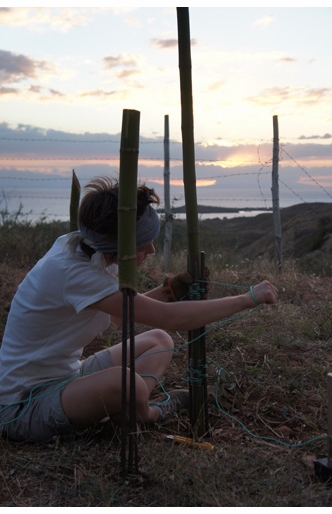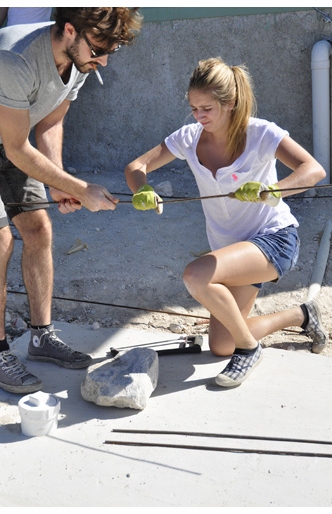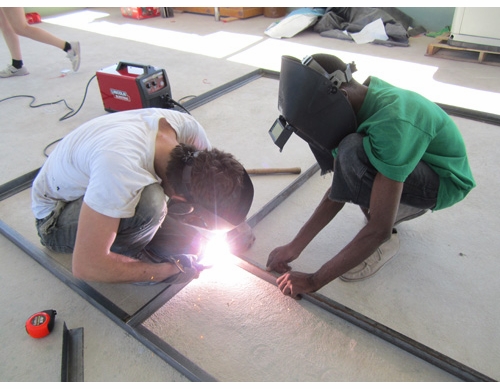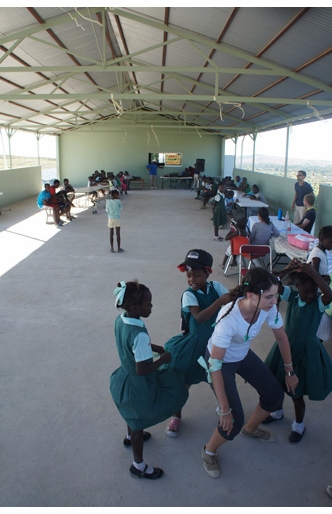| RECENT POSTS DATE 12/11/2025 DATE 12/8/2025 DATE 12/3/2025 DATE 11/30/2025 DATE 11/27/2025 DATE 11/24/2025 DATE 11/22/2025 DATE 11/20/2025 DATE 11/18/2025 DATE 11/17/2025 DATE 11/15/2025 DATE 11/15/2025 DATE 11/14/2025
| | | MARIE AQUILINO | DATE 4/4/2014This week on the Metropolis Books website (link at bottom of blog), 'Beyond Shelter' author Marie Aquilino reports on the successes and failures of her group's efforts in Titanyen, Haiti.
"Two days after we arrived the American team pulled in and unloaded dozens of duffle bags full of supplies and power tools from two white Avis 4x4s. Our team had become accustomed to the quiet.
We were working with relatively inexpensive ephemeral materials and improbable shapes in a studious process that required some pounding and sawing but was mainly a series of gestures and short instructions measured by lots of focused alone time sewing, tying, knotting, steadying. Cord was our only high-tech tool.
Hortense tying knots for merengue. Photograph by Marc-Antoine Galup.
Putting a little muscle into the work at the Montesinos Foundation. Photograph by Marc-Antoine Galup.
The Americans had a cement mixer, their own generator, and tools that could slice through and weld steel. They worked on the detailed fittings for a luxurious trellis system that would flare out from in front of the girl’s dormitories, capturing rainwater and providing permanent shade, (but only after they cut out the existing structure, which, if admittedly a poor cousin to their design, had been installed only two weeks earlier).
Welding. Photograph courtesy of The Center For Public Interest Design.
It would be easy to applaud the artisans and criticize the industrialists. But their bit of building is, in fact, smart and well-thought out. Yes, the kids adored our quirky shapes. But: bamboo is still an expensive, finicky material in Haiti; and although our structures can be repaired or duplicated--we left lots of extra materials behind--would anyone bother to patch the seams, retie the knots, replace the bamboo, or experiment with material options for the fun of it? Or would they simply become damaged and avoided like so many carcasses in Titanyen. We have our answer. The sea shells collapsed in 24 hours. No matter where we tried to place them, the wind was a threat. The bamboo poles quickly lost their covers to the gusts so the sun turned them into brittle and dangerous long sticks that succumbed to gymnastics. And the Nid has cracked and split in places. In spite of the children’s love for our aliens, three months later no one has taken on the repairs or investigated alternatives.
Finished roof for the veranda of the girls’ dormitory. Photograph courtesy of The Center For Public Interest Design
Sure, it would seem that by comparison the American team relied on heavy equipment, used lots of energy, built in more expensive materials and with a complicated design. But theirs will last. There is no risk that the wind will rip out the welds or skew the form. The verandas in front of the girls’ dormitories will provide predictable, lasting, dependable shade that will also add a slight advantage to the water budget. We could wish that the Americans had worked with one of the Haitian families that controls the steel or cement business, redoing their molds or simply providing local business; but this is not a seamless process and success is often determined by certain exclusions.
Perhaps the question of artisans vs. industrialists is not the one that matters most deeply. The comparison leads us away from what is truly at stake. Perhaps the question is better stated as: what in the world is the role of architecture schools in long-term recovery? After three years of working in Titanyen, which has been a rare and extraordinary privilege that has led to friendships, being blessed and sung to, and to having our hair braided, what can we say of value about our role in a project that has shifted radically over the six semesters..."
To read the rest of Aquilino's post, continue to the Metropolis Books website.
 Metropolis Books
Pbk, 8 x 8 in. / 304 pgs / 300 color.
| |
|





